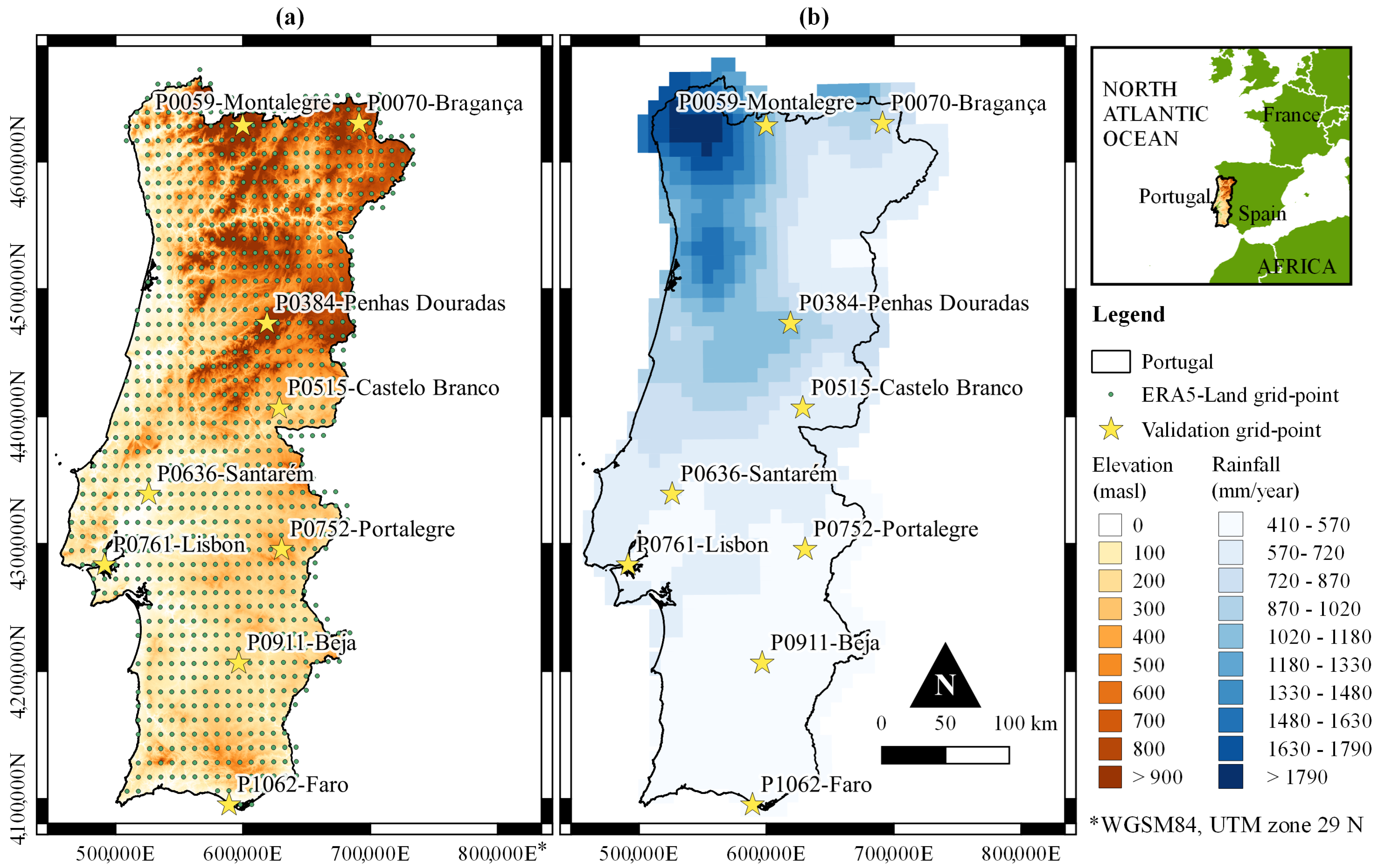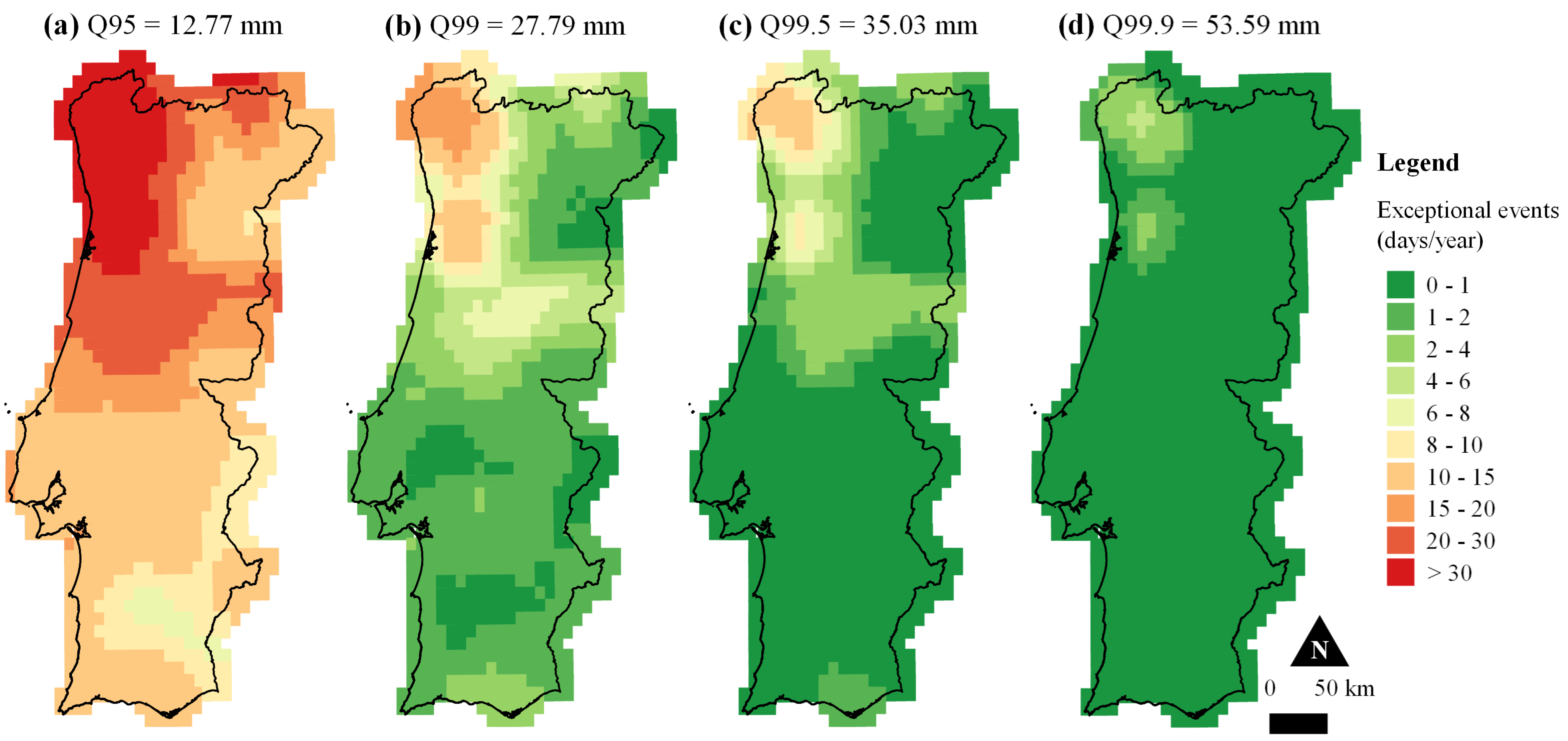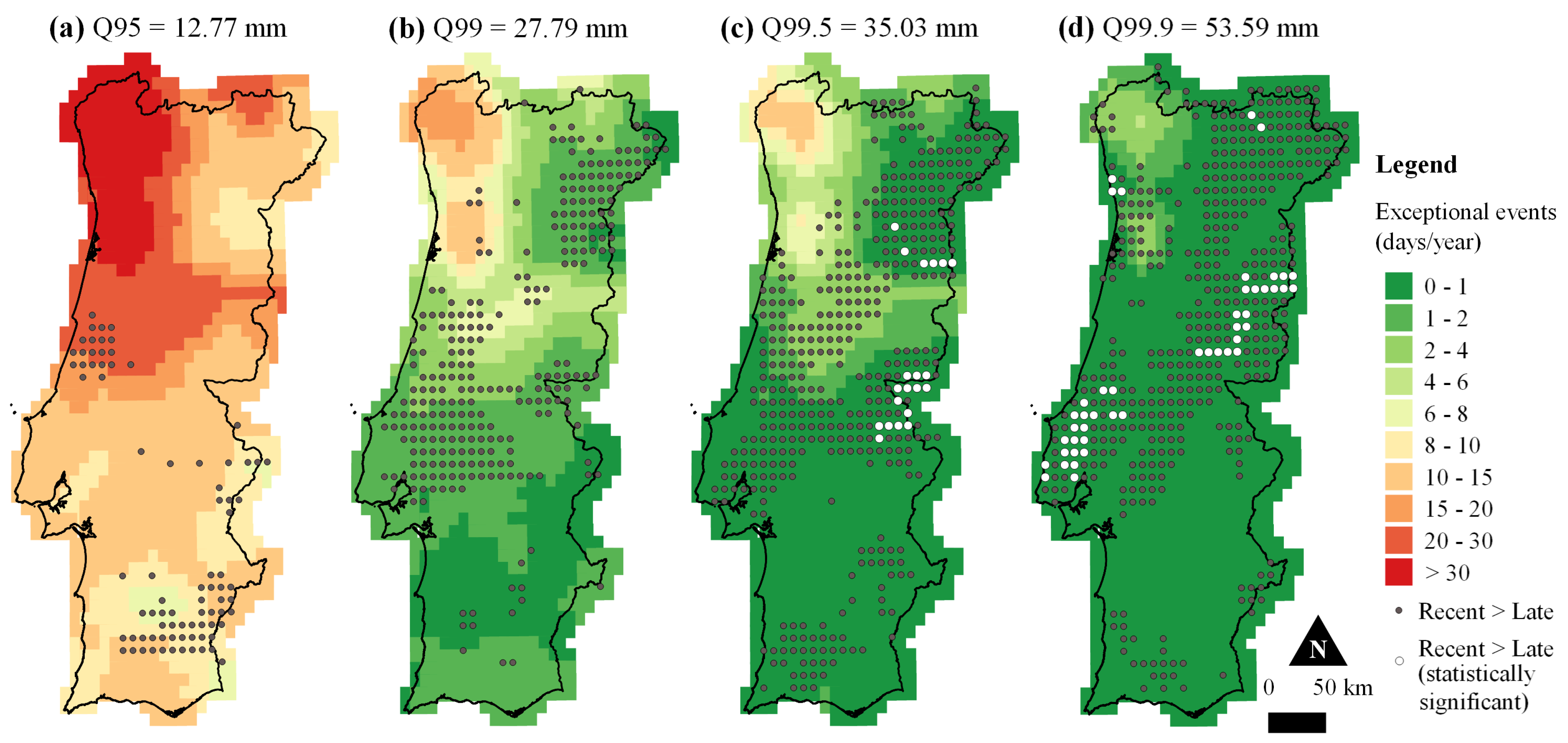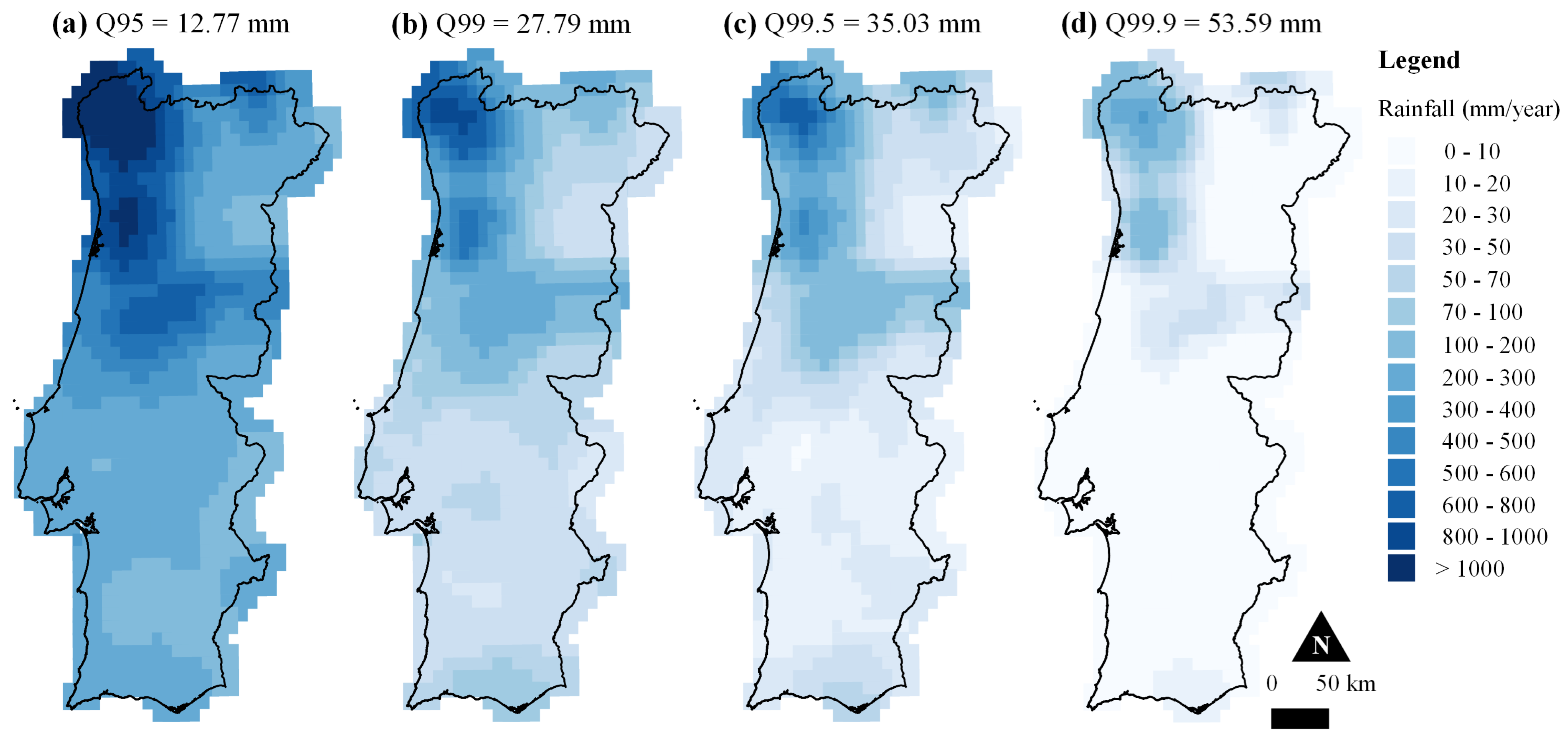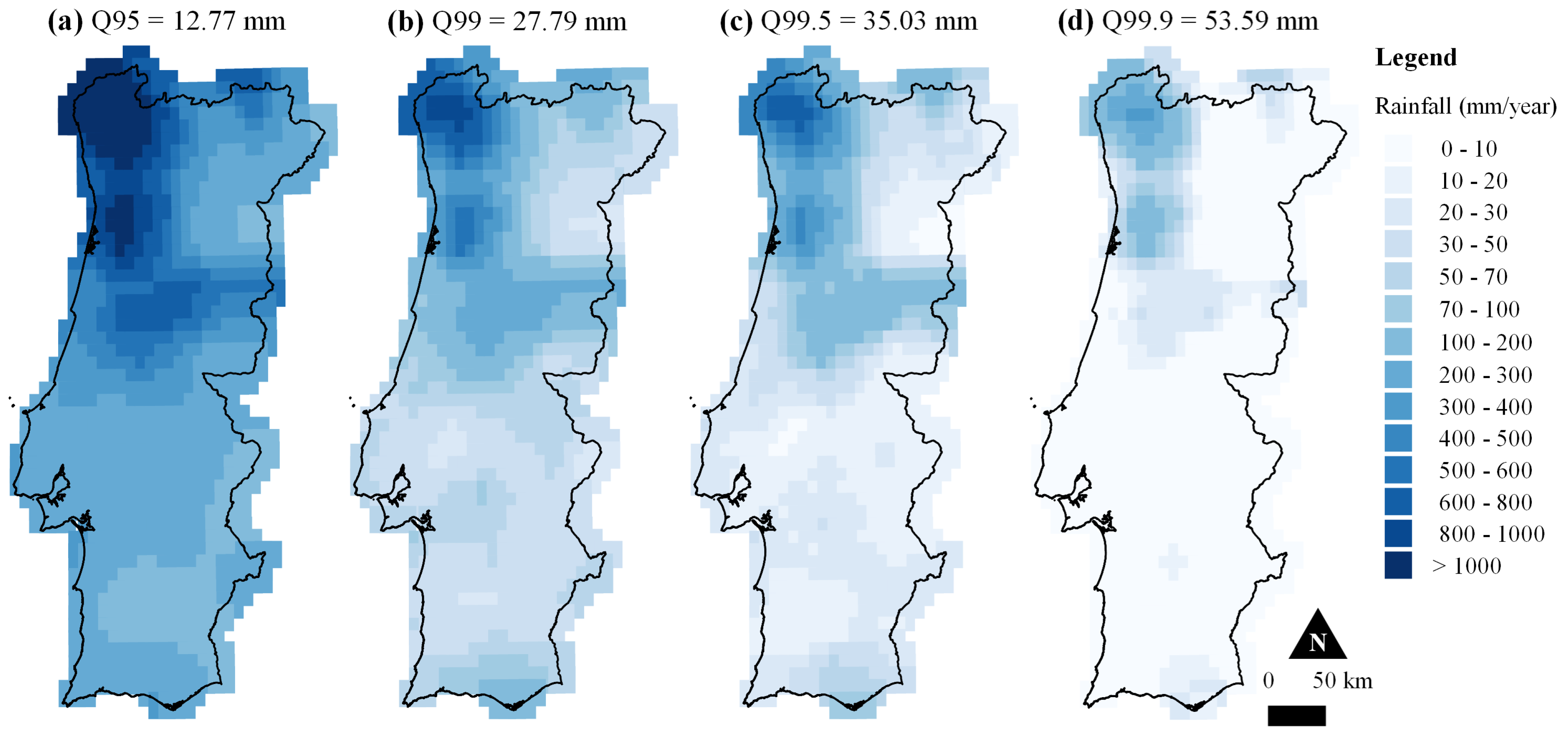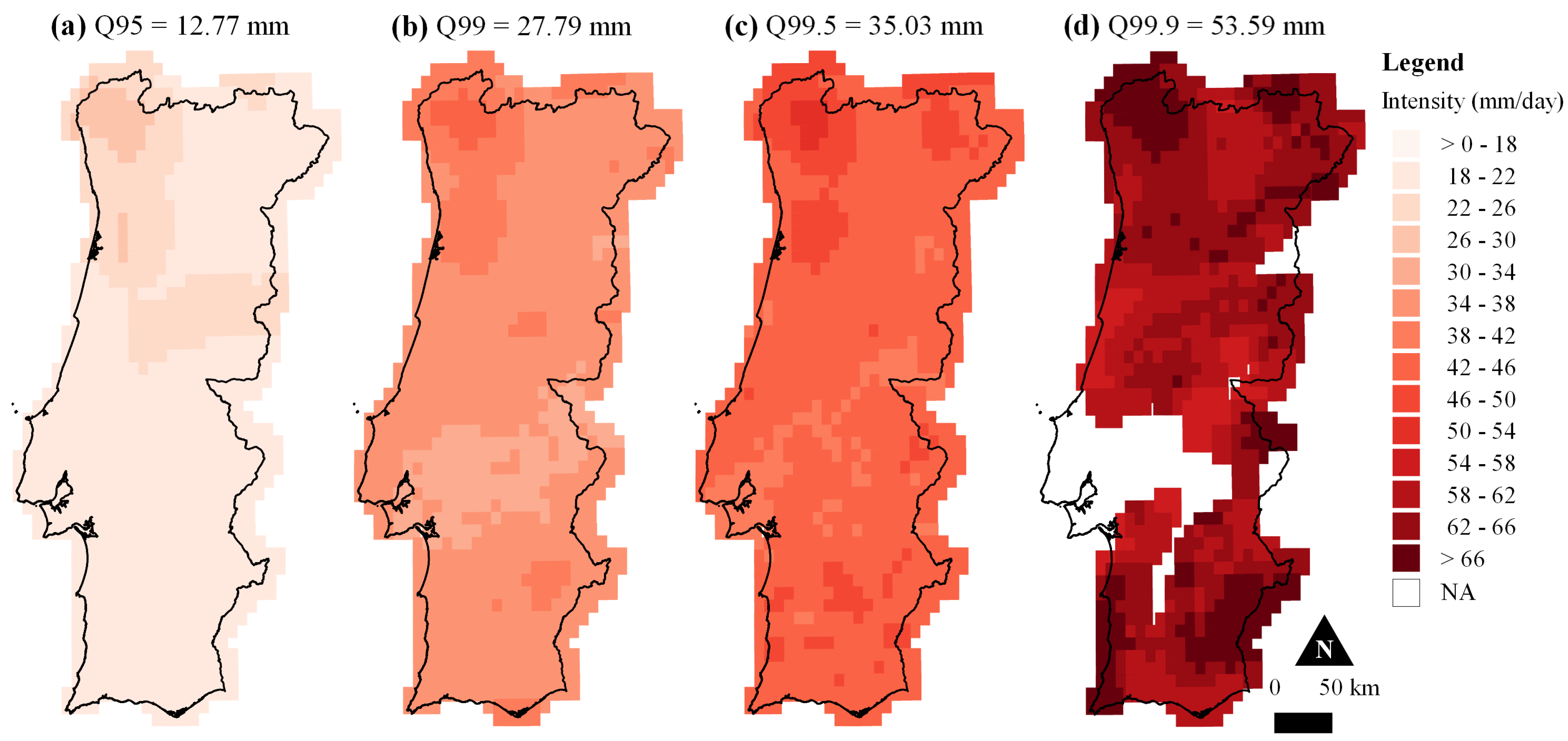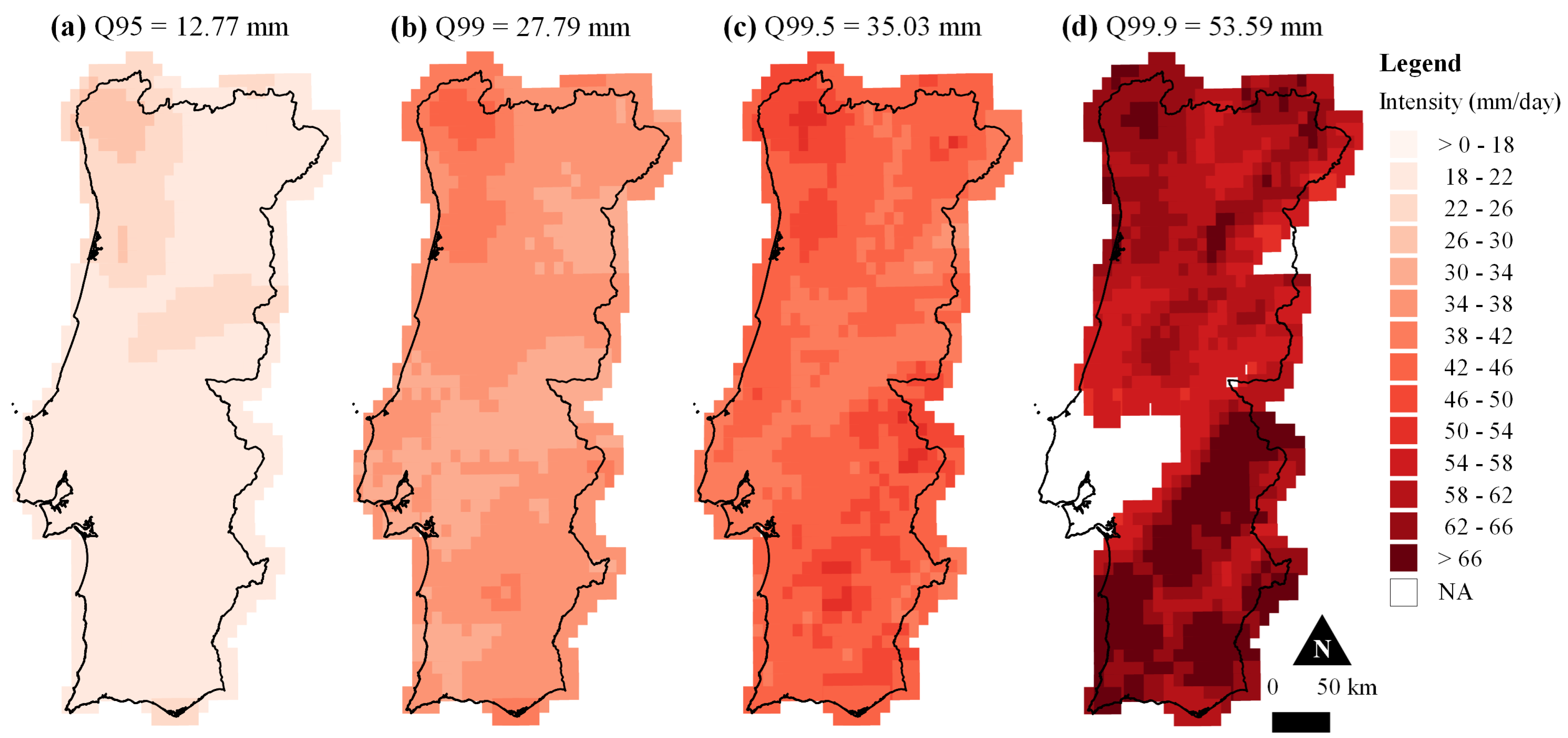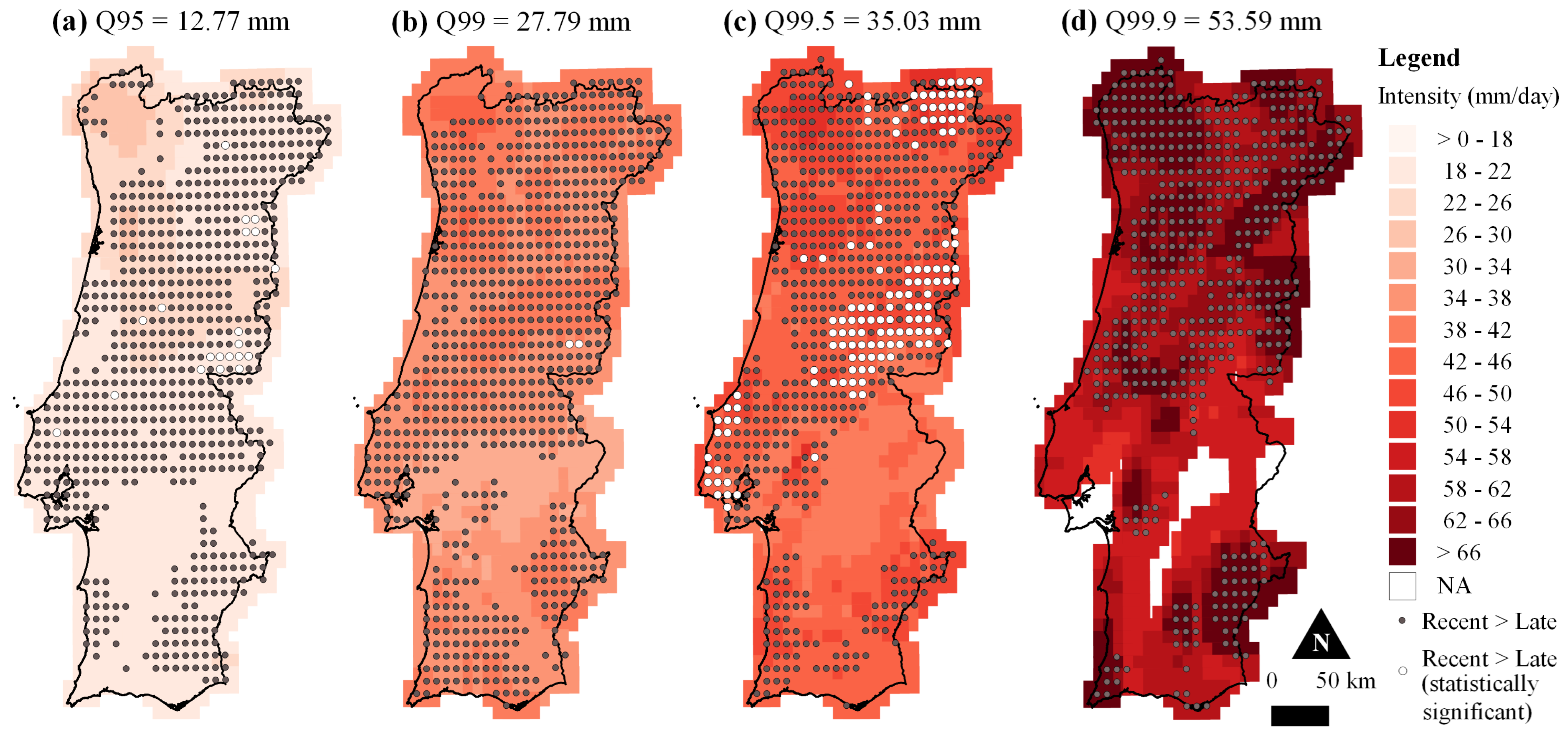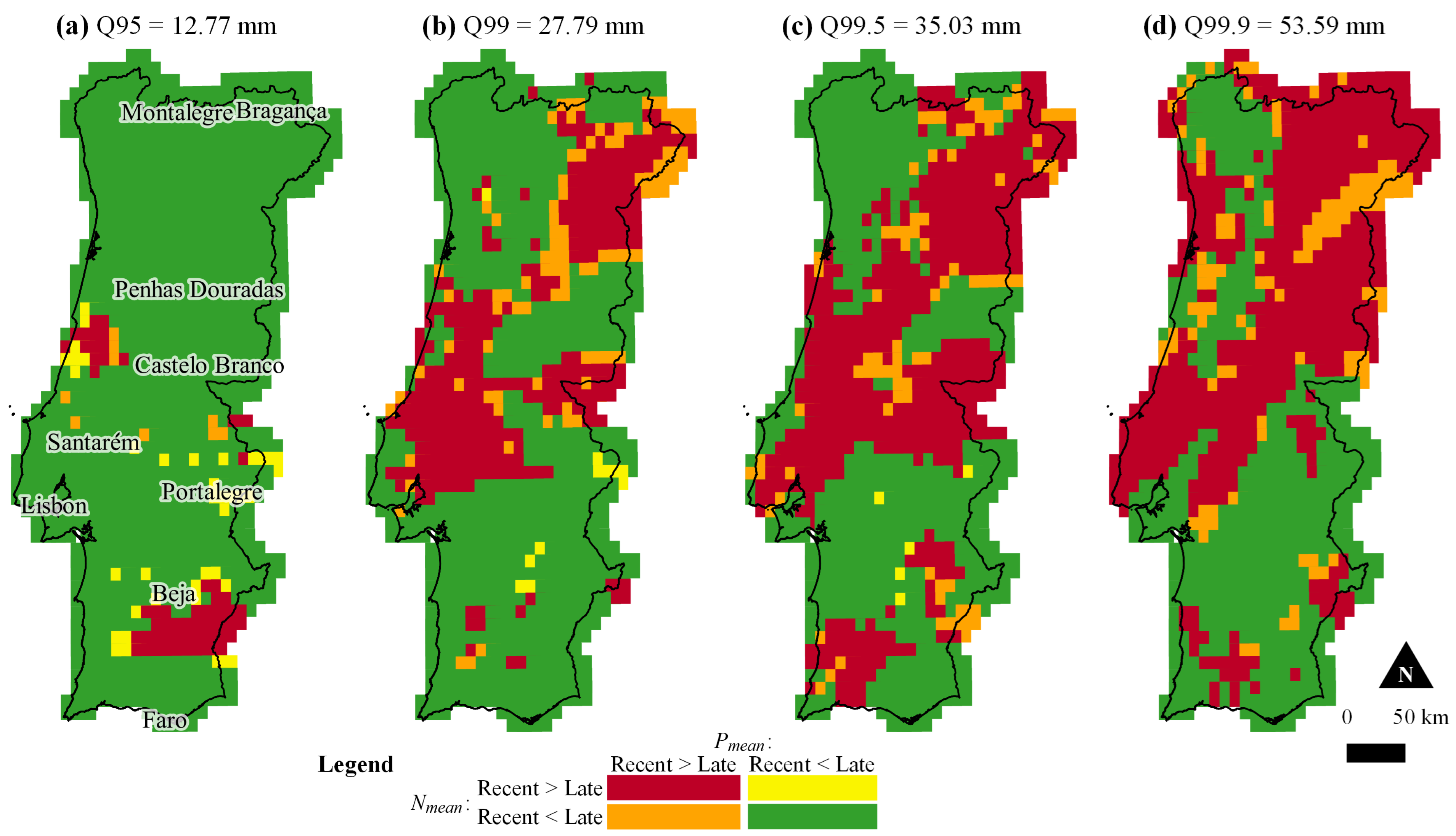1. Introduction
The assessment of changes in exceptional or extreme rainfall is integral to the comprehension of hydrological dynamics, particularly in regions such as Portugal, characterised by diverse topography (
Figure 1a) and climatic nuances that amplify the impact of extreme weather events [
1]. The current increased frequency and severity of intense rainfall, often linked to climate change, highlight the urgent need for in-depth studies [
2]. These investigations are crucial for understanding the characteristics and trends of such occurrences. As climate change continues to impact weather patterns, gaining insights into exceptional rainfall becomes essential [
3,
4]. This understanding is key due to the potential effects of these events on hydrological systems, water management, infrastructure resilience, and environmental sustainability. Portugal, a region spanning approximately 92,000 km
in the southwest of Europe and at the confluence of various climatic influences, emerges as a pertinent locale for an in-depth investigation into the hydrological implications of exceptional rainfall [
5,
6].
Numerous investigations have been conducted to delineate exceptional rainfall in Portugal, employing diverse datasets and methodological frameworks. Some of these inquiries have concentrated on appraising anticipated future alterations in exceptional rainfall across Portugal [
1]. Others have proposed comprehensive methodologies for evaluating rainfall thresholds linked to landslide initiation, drawing insights from a centenary landslide database alongside a corresponding centenary daily rainfall dataset [
7]. Furthermore, particular investigations have examined the apparent substantial impact of the North Atlantic Oscillation (NAO) mode on the inter-annual variability of intense and short-duration rainfall observed in Portugal and Spain [
8]. The existing body of research highlights the intricate nature of investigating these abnormal events and emphasises the need for robust methodologies to overcome the associated challenges. Several of these challenges are inherent in the examination of exceptional rainfall. For instance, discerning trends and attributing these events to specific causes becomes more intricate due to elevated noise levels and the influence of non-climatic factors. These factors contribute to the complexity of conducting meaningful studies [
9]. Additionally, climate change can disrupt long-term rainfall patterns, leading to increased flooding or prolonged droughts. This underscores the necessity for a careful delineation of the impacts of climate change on short-term exceptional events [
10]. Furthermore, the limitations ingrained in traditional meteorological station records, characterised by incomplete datasets and uneven spatial distribution, pose constraints on the comprehensive analysis of exceptional rainfall [
11]. To overcome these limitations, alternative datasets have also been employed in the examination of exceptional rainfall in Portugal. For instance, Ramos et al. [
12] made use of rainfall data from climate reanalysis, including the Twentieth Century Reanalysis (20thCR) and the NCEP Climate Forecast System (CFS) version 2, to examine variations in rainfall extremes across Portugal. More recently, Araújo et al. [
1] employed the IB02 Dataset, a high-density daily rainfall gridded dataset covering the Portuguese and Spanish domains from 1950 to 2008 at a spatial resolution of
. This dataset was collaboratively developed by Portuguese and Spanish meteorological offices by merging daily rainfall data for Portugal (PT02) with that for Spain (SPAIN02). These datasets offer valuable insights into exceptional rainfall in Portugal, contributing to various studies exploring spatial and temporal patterns as well as the potential impacts of climate change on these events. Nonetheless, there remain alternative datasets, such as the ERA5-Land reanalysis dataset [
13], that have not yet been explored comprehensively to elucidate the exceptionality of rainfall in Portugal.
In response to the previous methodological and data-related challenges, this investigation employs the ERA5-Land reanalysis dataset. This dataset, developed by the European Centre for Medium-Range Weather Forecasts (ECMWF), is publicly accessible through the Copernicus Climate Data Store (
https://cds.climate.copernicus.eu/cdsapp#!/home accessed on 10 October 2023). The ERA5-Land dataset stands out due to its noteworthy spatial resolution and consistent temporal coverage. The adoption of ERA5-Land not only rectifies the shortcomings associated with traditional meteorological datasets but also provides a more uniform, extensive, and continuous time series of daily rainfall data, encompassing Portugal.
This research study, spanning an overall period from 1 October 1981 to 30 September 2023 (42 hydrological years, 1981/1982–2022/2023), within the confines of Portugal, outlines two overarching objectives. Firstly, it aims to scrutinise the hydrological spatial dynamics of a region susceptible to climate-induced variations in exceptional rainfall. Secondly, the research aims to enhance the understanding of exceptional rainfall by utilising the open access and continuously updated ERA5-Land reanalysis dataset. In other words, it seeks to answer the research question, "Is the ERA5-Land reanalysis dataset able to replicate exceptional events close to those from meteorological station records?". The multifaceted objectives encompass the evaluation of the representativeness of ERA5-Land data, addressing the issue of incomplete records in rainfall series and assessing spatiotemporal patterns of exceptional rainfall over the study period.
An integral part of the methodology involves validating ERA5-Land daily rainfall data against records from the
Sistema Nacional de Informação de Recursos Hídricos (SNIRH) and the Portuguese Institute for Sea and Atmosphere (IPMA). This validation process acts as a crucial assessment of the reliability of ERA5-Land data, addressing the persistent challenge posed by incomplete daily rainfall records and ensuring a representative picture of Portugal’s climatology. Furthermore, drawing upon existing scientific literature, the ERA5-Land dataset has been featured in several studies assessing exceptional rainfall across diverse regions. For instance, Lavers et al. [
14] scrutinised the efficacy of ERA5 rainfall for climate monitoring and observed broad agreement between rainfall patterns in ERA5 and observations during extreme events. Additionally, another study appraised the ERA5-Land reanalysis rainfall dataset over Spain, concluding that ERA5 performs commendably in analysing extreme rainfall in that region [
15]. Although ERA5-Land has been extensively employed in broader climate analyses, its capability to faithfully represent exceptional rainfall in Portugal remains unexplored. This study aims to fill this gap in the current scientific literature by examining ERA5-Land’s ability to capture or reproduce exceptional rainfall over the past four decades.
The subsequent sections of this scientific manuscript will delve into the intricacies of the methodology, present ERA5-Land dataset validation results, and provide a comprehensive exploration of the spatiotemporal changes of the exceptional rainfall, including its occurrence, cumulative rainfall, and intensity. By embedding this research within the evolving discourse on exceptional rainfall in Portugal, the study addresses broader implications for sustainable water resource management. This involves discussing the combinations of occurrences and cumulative rainfall over adopted thresholds during both the late (1981/1982–2001/2002) and recent (2002/2003–2022/2023) subperiods.
3. Results
As mentioned, the spatiotemporal dynamics of exceptional rainfall in Portugal were examined using the ERA5-Land reanalysis dataset. Throughout the overall period of 42 hydrological years (1981/1982–2022/2023) and the two 21-hydrological-year subperiods, i.e., late and recent subperiods, the spatial distribution and temporal changes of occurrences, cumulative rainfall, and intensity for these exceptional events were investigated. The analysis, based on a validated ERA5-Land dataset against established meteorological records (1980–2021), provides insights into the hydrological impacts of climate-induced variations in exceptional rainfall across Portugal.
3.1. Empirical Non-Exceedance Probability Curves for Validation of the ERA5-Land Dataset
Normalised rainfall–non-exceedance probability (NR-NEP) plots were generated for the nine reanalysis datasets and forty-five observational record series within selected regions or urban areas—Motalegre, Bragança, Penhas Douradas, Castelo Branco, Santarém, Portalegre, Lisbon, Beja, and Faro—as illustrated in
Figure 1. The NR-NEP plots, known as empirical non-exceedance probability curves, represent the non-exceedance probabilities of normalised rainfall values (daily rainfall/long-term average daily rainfall). The curves depicted in
Figure 2 enabled a comparative evaluation between the reanalysis data and observational records at specific geographic locations for higher probabilities (≥0.80), assumed in this case to represent the range of exceptional daily rainfall.
The long-term average of daily rainfall, considering 15,330 values excluding leap year days, was calculated for each of the nine grid points from 1 January 1980 to 31 December 2021: P0059, 3.36 mm; P0070, 2.48 mm; P0384, 2.79 mm; P0515, 1.75 mm; P0636, 1.62 mm; P0752, 1.55 mm; P0761, 1.55 mm; P0911, 1.28 mm; and P1062, 1.38 mm. These values distinctly highlight the heterogeneity in rainfall distribution, revealing a wetter pattern in the north compared to the south. This variability in rainfall distribution is an important aspect to consider in the analysis of regional hydrological dynamics.
In
Figure 2, only meteorological stations with data availability exceeding 50% are displayed among the five closest stations to each reanalysis grid point (P). The northernmost locations (Portalegre, Bragança, and Penhas Douradas) displayed the lowest number of rainfall record series, with each having only three stations that met this criterion. This was followed by the most interior location, Penhas Douradas, and Lisbon, each having four rainfall record series (with an overall record availability of 82%). The remaining locations had rainfall series meeting the record availability threshold, with an average of 73% complete records, and while some record series had an acceptable number of records, none of them achieved completeness comparable to the reanalysis series. This underscores the superior completeness of the reanalysis series compared to the observational records.
The shapes of the non-exceedance curves were examined to evaluate the ERA5-Land’s capability to replicate the characteristics of exceptional events from rainfall records. Overall, as depicted in
Figure 2, there is a notable agreement between the curves derived from the reanalysis data and rainfall records. However, in certain northern locations (e.g., Montalegre,
Figure 2a), the ERA5-Land dataset slightly overestimates the exceptionality of rainfall. Nevertheless, the overall consistency of the non-exceedance curves was taken into account to affirm the reliability of the ERA5-Land dataset for the subsequent analysis of exceptional events. Following validation, four thresholds for identifying exceptional events were established from the 1012 gridded daily rainfall dataset (1981/1982–2022/2023), yielding a Q95 of 12.77 mm, Q99 of 27.79 mm, Q99.5 of 35.03 mm, and Q99.9 of 53.59 mm.
3.2. Occurrences of Exceptional Rainfall
A pixelated spatial representation of results pertaining to the occurrences of exceptional rainfall across different thresholds—for the overall period (
Figure 3) and the two subperiods (
Figure 4 and
Figure 5)—played a crucial role in acquiring comprehensive insights into the spatial distribution and frequency of exceptional episodes, each identified by specific rarity levels. Through the examination of the mean annual number of daily occurrences above the four quantile thresholds (Q95, Q99, Q99.5, and Q99.9), patterns ranging from moderately rare to highly exceptional events were discerned, elucidating the nuances of their temporal evolution. The differentiation between the late and recent subperiods enabled a temporal assessment of changes in these occurrences, providing insights into potential shifts or intensifications in exceptional rainfall over the past four decades.
In
Figure 3a, it is evident that the occurrence of exceptional events (with an average of 18.25 days/year) for the lowest quantile threshold, namely Q95, is higher in the northwestern coastal regions. Conversely, the northeastern and interior regions, as well as the central part of Beja (P0911) in the south, depict the lowest occurrences of exceptional rainfall. This differentiated behaviour indicates that the spatial development of the phenomenon does not follow a straightforward north–south pattern. This heterogeneous behaviour is also observed for the other thresholds (
Figure 3b–d), albeit with a lower number of occurrences, sometimes even fewer than one exceptional event per year—for example, an average of 0.36 days/year for the Q99.9 threshold.
The accompanying maps for the previous results, as illustrated in
Figure 4 for the late subperiod and
Figure 5 for the recent subperiod, show similar patterns in the geographical distribution of exceptional events compared to the overall period. However, a more detailed comparison of the results from the two subperiods offers insights into temporal changes in the occurrence of exceptional rainfall. In
Figure 5, by simply examining the number of points with higher occurrences in the recent subperiod than in the late subperiod, it can be observed that the number of points out of the 1012 (100%) grid points increases as the threshold increases, i.e., 82 (8.3%) for Q95, 277 (27.4%) for Q99, 435 (43.0%) for Q99.5, and 483 (47.7%) for Q99.5. Following the application of the
t-test (Equation (
1)), statistically significant changes in the number of occurrences between the two subperiods were observed solely for the highest thresholds, Q99.5 and Q99.9, at 20 and 46 grid points, respectively, (see
Figure 5). Furthermore, the number of occurrences for the recent subperiod was divided by those for the late subperiod. The resulting values were weighted by the relative percentage of points with higher values in the recent subperiod and those with higher values in the late subperiod. This analysis revealed a decrease in occurrences of −5.8% for Q95 and −2.7% for Q99, in contrast to increases for higher thresholds, specifically, 1.4% for Q99.5 and 10.6% for Q99.9. These findings highlight shifts in the number of occurrences of exceptional events in the recent subperiod compared to the late one.
3.3. Cumulative Rainfall above the Threshold
The investigation into cumulative impacts, specifically in terms of cumulative rainfall resulting from exceptional rainfall and analysed across distinct thresholds using the ERA5-Land dataset, is delineated for the overall period (
Figure 6) and the two subperiods (
Figure 7 and
Figure 8). This part of the analysis delves into the mean annual cumulative rainfall above the same four quantile thresholds (Q95, Q99, Q99.5, and Q99.9), offering enhanced insights into the spatial and temporal evolution of cumulative impacts.
According to
Figure 1b, the mean annual rainfall throughout the 42 hydrological years of the overall period is 787.0 mm/year, with a pronounced concentration in the northwestern part of Portugal, where locations exceed 1200.0 mm/year (e.g., P0059 grid point in the Montalegre vicinity with 1238.9 mm/year). The highest mean annual rainfall is situated in the north, specifically in the region of Braga (P0079 with 1934.3 mm/year), while the lowest is in the south in Faro (P1045 with 411.3 mm/year). From
Figure 6, the contribution of the cumulative rainfall to the previous mean annual rainfall values, on average for each of the thresholds, is 51.7% for Q95 (407.1 mm/year), 18.0% for Q99 (141.3 mm/year), 10.8% for Q99.5 (84.8 mm/year), and 3.0% for Q99.9 (23.9 mm/year).This comparison provides insights into the distribution and magnitude of cumulative impacts resulting from exceptional rainfall across various thresholds. It is evident that Q95 significantly contributes to cumulative rainfall, whereas higher rarity thresholds, such as Q99.5 and Q99.9, make comparatively smaller contributions, as expected.
In the late subperiod (
Figure 7a–d), the mean annual values of cumulative rainfall are 419.8 mm/year for Q95, 144.8 mm/year for Q99, 86.1 mm/year for Q99.5, and 23.9 mm/year for Q99.9. Conversely, during the recent subperiod (
Figure 8a–d), the corresponding figures are marginally lower for the first three thresholds, with values of 394.4 mm/year, 137.9 mm/year, 83.6 mm/year, and 24.6 mm/year, respectively. This observation suggests an overall decrease in cumulative rainfall from the late subperiod to the most recent one, with the exception of Q99.9, which experienced an approximate 6% increase. Upon comparing
Figure 7 and
Figure 8, substantial intensifications of the phenomenon become apparent. The number of locations with higher cumulative rainfall in the recent subperiod has increased in more than half of the grid for the most rare threshold (
Figure 8d), occurring in 59 grid points (5.8%) for Q95, 348 grid points (34.4%) for Q99, 504 grid points (49.8%) for Q99.5, and 580 grid points (57.3%) for Q99.9, with the latter two showing 14 and 45 statistically significant results (rejecting
and accepting
), respectively. Accordingly, the increase in these grid points from one subperiod to the next has been 2.5%, 9.5%, 8.0%, and 42.9%. This evidence indicates that despite the decrease in cumulative rainfall totals, the most rare and exceptional events have somewhat intensified.
The cumulative impacts are significant contributors to extreme weather events, including floods and landslides, which have substantial implications for environmental systems, infrastructure, and communities [
25,
26]. A detailed understanding of cumulative impacts is instrumental for improved risk assessment and management, particularly in regions susceptible to such occurrences [
27,
28]. Building upon the insights gained from the occurrences of exceptional rainfall, this exploration into cumulative impacts adds a layer of depth to the comprehension of hydrological dynamics in Portugal, aimed at providing a foundation for strategies in infrastructure planning, climate change adaptation, and overall resilience.
3.4. Rainfall Intensity of Exceptional Events
The investigation into rainfall intensity emerged from a coupled analysis of the number of occurrences and cumulative rainfall. Rainfall intensity, defined in this application as the annual cumulative rainfall divided by the annual number of occurrences of daily rainfall surpassing the threshold, furnishes a focused perspective on the concentration and vigour of exceptional events. This facilitates the discernment of whether changes in occurrences and cumulative impacts are mirrored by alterations in the intensity of exceptional rainfall. This metric also offers valuable insights into the efficiency with which such events contribute to cumulative impacts, including factors such as floods and landslides, as mentioned at the end of the previous subsection. The spatial representation of the mean annual values of the rainfall intensity of exceptional events is illustrated in
Figure 9 for the 42-hydrological-year overall period,
Figure 10 for the late 21-hydrological-year subperiod, and
Figure 11 for the recent 21-hydrological-year subperiod. The examination of how the intensity of these events varies across quantile thresholds and subperiods contributes to a more comprehensive assessment of hydrological trends.
The spatial distribution of the mean annual rainfall intensity of exceptional events across Portugal during the overall period, presented in
Figure 9, highlights regional variations. Areas with heightened rainfall intensity are evident for Q95 in the northern coastal regions and Castelo Branco (P0515) in the interior. As the threshold increases, the distribution of rainfall intensity shows more heterogeneous behaviour (e.g., for Q99 and Q99.5). However, for the highest threshold (
Figure 9d), the distribution of more intense events shifts, compared to the lowest quantile, and is focused on the interior region of Portalegre (P0752), at the same latitude as Lisbon (P0761), and in the south of the country, such as in the western coast and the centre of Beja (P0911). This demonstrates that despite these locations having the lowest mean annual cumulative rainfall (
Figure 6d), they denote the highest intensity, underscoring the significant role of the interaction of occurrences and cumulative impacts.
In the 42-hydrological-year overall period (1981/1982–2022/2023), it is noteworthy that 37 reanalysis locations reported no occurrences whatsoever of events above the Q99.9 threshold, resulting in no cumulative rainfall above the threshold and, consequently, no intensity. However,
Figure 9d has been constructed with only 753 grid points that have occurrences in both the late and recent subperiods, omitting 259 grid points denoted as “Not Applicable” (NA). In the 1981/1982–2001/2002 subperiod (
Figure 10d), 160 grid points have no occurrences (i.e., 160 NAs), whereas in the 2002/2003–2022/2023 subperiod (
Figure 11d), there are 136 NAs. This reflects a decrease in the number of locations without exceptional events from the late to the most recent 21 years, also highlighting areas presenting quite rare events, such as southern Santarém (P0636) and the Lisbon (P0761) district. Concerning rainfall intensity, it has increased in more than half of the grid points, regardless of the threshold. Categorically, out of the 1012 grid points, 724 points (71.5%) exhibit higher mean annual rainfall intensity in the recent subperiod in comparison to the late one for Q95 (
Figure 11a), 776 points (76.7%) for Q99 (
Figure 11b), 678 points (67.0%) for Q99.5 (
Figure 11c), and 602 points (59.5%) for Q99.9 (
Figure 11d). In the previous figures, 20 grid points denoted statistically significant results for Q95, 2 grid points for Q99, and 132 grid points for Q99.5. For Q99.9, the
t-test could not be applied due to the high number of NAs in some cases, i.e., the number of elements failed to ensure the representativeness of the compared samples (less than 20 elements). The notorious reduction in locations without exceptional events and the heightened intensity across various thresholds underscore the dynamic nature of hydrological processes in Portugal. This changing scenario emphasises the necessity for continuous monitoring and adaptive strategies to address the evolving risks associated with exceptional rainfall.
The intricate interplay between occurrences and cumulative rainfall (i.e., rainfall intensity) contributes to a comprehensive understanding of the patterns governing exceptional rainfall across different regions and quantile thresholds. This insight carries implications for targeted risk mitigation and adaptation strategies, particularly in regions with lower cumulative rainfall that may still face heightened intensity, posing a unique set of challenges. This detailed examination highlights the evolving pattern of exceptional rainfall, exemplified by the shift of the most intense events from south to north, as observed by comparing
Figure 10d to
Figure 11d. These shifts indicate changes in occurrence patterns and an overall increase in rainfall intensity.
5. Conclusions
The examination of exceptional rainfall dynamics in Portugal over 42 hydrological years has yielded specific conclusions with significant implications. Firstly, the reliability of the ERA5-Land dataset for analysing exceptional rainfall was underscored by its validation against daily observational records, despite minor discrepancies observed in certain northern regions. This validation provides a robust foundation for upcoming investigations. Secondly, regional variations in occurrences, cumulative rainfall, and rainfall intensity were highlighted, emphasising the heterogeneous nature of exceptional rainfall patterns across Portugal. The observed shifts in intense events from south to north over the last twenty years underscored the dynamic hydrological processes that have shaped the country’s landscape. Thirdly, the integration of a severity heat map introduced a novel approach to visualising the combined characteristics of exceptional rainfall, revealing increasing severity and spatial extent at higher thresholds (e.g., Q99.5 and Q99.9), particularly in coastal cities. This innovative visualisation tool enhances the understanding of the evolving risks associated with exceptional rainfall events. Overall, these findings emphasise the importance of continuous monitoring and adaptive strategies to address the changing hydrological dynamics in Portugal, informing more effective risk management and sustainable development initiatives tailored to the country’s evolving rainfall patterns and climate conditions. Future work should explore shorter timescales (e.g., subdaily), evaluate climate change impacts, and consider detailed land-use patterns for a more comprehensive risk assessment.
